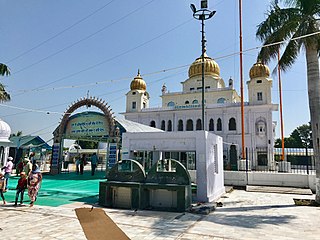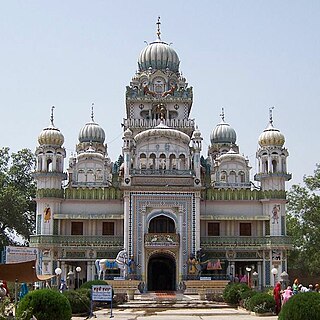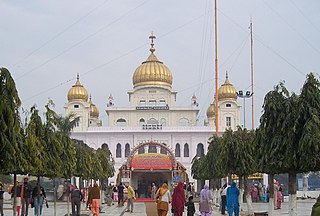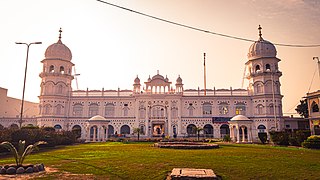Related Research Articles

Anandpur Sahib, also referred simply as Anandpur, is a city in Rupnagar district (Ropar), on the edge of Shivalik Hills, in the Indian state of Punjab. Located near the Sutlej River, the city is one of the most sacred places in Sikhism, being the place where the last two Sikh Gurus, Guru Tegh Bahadur and Guru Gobind Singh, lived. It is also the place where Guru Gobind Singh founded the Khalsa Panth in 1699. The city is home to Takhat Sri Kesgarh Sahib, Third of the five Takhts in Sikhism.

The Takht Sri Darbar Sahib Damdama Sahib, is one of the five takhts or Seat of Temporal Authority of Sikhism, located in Talwandi Sabo in Punjab, India. At this place Guru Gobind Singh, the tenth Sikh Guru, prepared the full version of the Sikh scriptures called Sri Guru Granth Sahib in 1705. The other four Takhts are the Akal Takht, Takht Sri Keshgarh Sahib, Takht Sri Patna Sahib and Takht Sri Hazur Sahib.

Fatehgarh Sahib is a city and a sacred pilgrimage site of Sikhism in the north west Indian state of Punjab. It is the headquarters of Fatehgarh Sahib district, located about 5 kilometres (3.1 mi) north of Sirhind. Fatehgarh Sahib is named after Fateh Singh, the 7-year-old son of Guru Gobind Singh, who was seized and buried alive, along with his 9-year-old brother Zoravar Singh, by the Mughals under the orders of governor Wazir Khan during the ongoing Mughal-Sikh wars of the early 18th century. The town experienced major historical events after the martyrdom of the sons in 1705, with frequent changes of control between the Sikhs and Mughals.

Majha is a region located in the central parts of the historical Punjab region split between India and Pakistan. It extends north from the right banks of the river Beas, and reaches as far north as the river Jhelum. People of the Majha region are given the demonym "Mājhī" or "Majhail". Most inhabitants of the region speak the Majhi dialect, which is the basis of the standard register of the Punjabi language. The most populous city in the area is Lahore on the Pakistani side, and Amritsar on the Indian side of the border.

Fateh Singh, commonly referred to with honorifics as Baba Fateh Singh or Sahibzada Baba Fateh Singh, was the fourth and youngest son of Guru Gobind Singh.
The Battle of Bhangani was fought between Guru Gobind Singh's army and Bhim Chand (Kahlur) of Bilaspur on 18 September 1686 or 1688, at Bhangani near Paonta Sahib. An alliance of Rajput Rajas of the Shivalik Hills participated in the engagement on behalf of Bhim Chand of Bilaspur State's side, including the states of Garhwal and Kangra. It was the first battle Guru Gobind Singh, the tenth Sikh Guru, fought at the age of 19.

Shaheedi Sabha is a three-day annual religious congregation (get-together) organised every year in December at Gurdwara Fatehgarh Sahib, in the Fatehgarh Sahib district of Punjab, India to pay homage to the martyrdom of Chhotte Sahibzade Baba Zorawar Singh and Baba Fateh Singh, the youngest sons of the 10th sikh guru Guru Gobind Singh.
Gurdwara Bal Lila Maini Sangat in a narrow lane close to Takht Sri Harmandir Sahib marks the house where King Fateh Chand Maini lived. His childless Queen had developed special fondness for the young Guru Gobind Singh, who, too, often came here to sit in the Queen's lap giving her immense delight and spiritual solace. She fed the Child Gobind and his playmates, at his demand, with boiled and salted gram. Even now boiled and salted gram is served as prasad in this Gurdwara, which, unlike the other shrines in Patna Sahib, is served by Nirmala Sikhs. A wood carving on the old front door is dated 28 August 1668, but the hall housing the sanctum and other blocks of rooms in the inner compound have been reconstructed during recent decades.

Gurdwara Mehdiana Sahib, also called the 'School of Sikh History' is a Sikh gurdwara located in the village of Mehdiana, just outside Mallha, near Jagraon in Ludhiana district, India.

Gurdwara Fatehgarh Sahib is a Sikh gurdwara or place of worship in the city of Fatehgarh Sahib in the Indian state of Punjab. The gurdwara marks the 1710 conquest of the city by the Sikhs under the leadership of Banda Singh Bahadur. Sikhs captured the area and razed the fort built by Ferozshah Tughlaq to the ground.

Malaysian Sikhs are known to be the fourth largest Malaysian Indian ethnic group. It is estimated that there are around 100,000 Sikhs in Malaysia.

Gurdwara Janam Asthan, also referred to as Gurdwara Nankana Sahib, is a highly revered gurdwara that is situated at the site where the founder of Sikhism, Guru Nanak, was born. The shrine is located in Nankana Sahib, Punjab, Pakistan.

Hazur Sahib, also known as Takht Sachkhand Sri Hazur Abchalnagar Sahib, is one of the five takhts in Sikhism. The gurdwara was built between 1832 and 1837 by Maharaja Ranjit Singh (1780–1839). It is located on the banks of the Godavari River at the city of Nanded in the state of Maharashtra, India.

Jathedar Baba Chet Singh (1914–1968) was a Nihang and was 12th Jathedar of Budha Dal after Baba Sahib Ji Kaladhari. He was born in 1914 at Talwandi. His father's name was Gurdit Singh and mother was Pradhan Kaur. He was succeeded by Jathedar Santa Singh Nihang. He died in 1968 at the age of 54. His memorial is located at Damdama Sahib. Among his famous saying was Fateh Singh Ke Jathe Singh, which he use for Nihang Army.
Akali Dal – Sant Fateh Singh Group was one of several hard-line splinter groups founded by Sant Fateh Singh. Akali Dal – Sant Fateh Singh was formed in 1962. It is led by Sant Fateh Singh. The party was a Sikh-centered political party in the Indian state of Punjab. The party was created due to disagreement between Master Tara Singh and Sant Fateh Singh. The party gained control of the Shiromani Gurdwara Prabandhak Committee in October 1962. In the Gurdwara elections in January 1965, the party annexed 90 of the seats, while Master Tara Singh's party could manage only 45. In 1967 during Punjab Legislative Assembly election Party got 24 seats and with the support of other Parties and Independents under the leadership of Gurnam Singh formed People's United Front and the government but resigned after defection by Lachhman Singh Gill and then both factions merged and formed Shiromani Akali Dal on 7 October 1968 at Khadur Sahib.
Siahar is a village in Ludhiana district in the Indian state of Punjab. Siahar is the birthplace of Dhan Dhan Sri Hazur Sant baba Mihan Singh ji. Baba G is popular for its love for Guru Granth Sahib ji.

Khanda Museum is a museum located at Fatehgarh Sahib and its building constructed in shape of Sikh religious symbol Khanda. The museum is built by SGPC in the memory of Sikh-warrior Banda Singh Bahadur and would exhibit his history. The museum is located near Gurdwara Fatehgarh Sahib. The museum opened on 7 January 2018.
Akali Dal – Master Tara Singh Group was one of several hard-line splinter groups founded by Tara Singh. Akali Dal – Tara Singh was formed in 1962. It was led by Master Tara Singh. The party was a Sikh-centered political party in the Indian state of Punjab. The party was created due to disagreement between Master Tara Singh and Sant Fateh Singh. The party failed to gained control of the Shiromani Gurdwara Prabandhak Committee in October 1962. In the Gurdwara elections in January 1965, the party annexed 45 of the seats, while Sant Fateh Singh's party could manage 90. In 1967 during Punjab Legislative Assembly election Party got only 2 seats and gave their support to Akali Dal Sant Fateh Singh with other Parties and Independents and formed People's United Front and the Government under the leadership of Gurnam Singh but resigned after defection by Lachhman Singh Gill and then both the factions merged and formed Shiromani Akali Dal on 7 October 1968 at Khadur Sahib.
References
- ↑ Gurdwara Toka Sahib at Worldgurudwaras.com
- ↑ thesikhencyclopedia: Retrieved information of Gurdwara Toka Sahib
- ↑ Biography of Fateh Singh: Balwinder Singh. Retrieved from Labana Sewak, January 2005